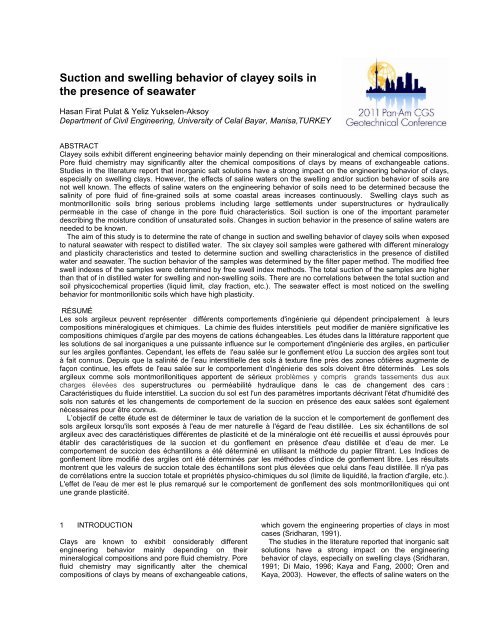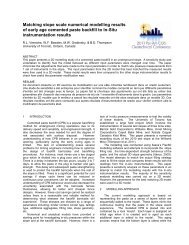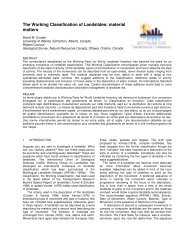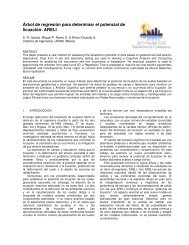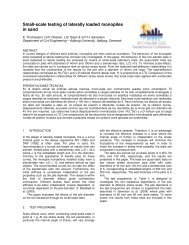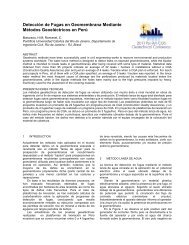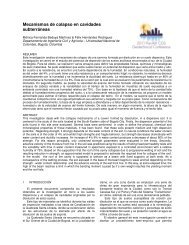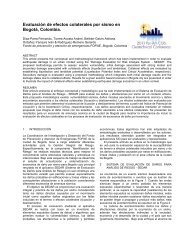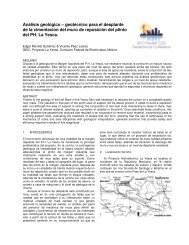You also want an ePaper? Increase the reach of your titles
YUMPU automatically turns print PDFs into web optimized ePapers that Google loves.
Suction and swelling behavior of clayey soils inthe presence of seawaterHasan Firat Pulat & Yeliz Yukselen-AksoyDepartment of Civil Engineering, University of Celal Bayar, Manisa,TURKEYABSTRACTClayey soils exhibit different engineering behavior mainly depending on their mineralogical and chemical compositions.Pore fluid chemistry may significantly alter the chemical compositions of clays by means of exchangeable cations.Studies in the literature report that inorganic salt solutions have a strong impact on the engineering behavior of clays,especially on swelling clays. However, the effects of saline waters on the swelling and/or suction behavior of soils arenot well known. The effects of saline waters on the engineering behavior of soils need to be determined because thesalinity of pore fluid of fine-grained soils at some coastal areas increases continuously. Swelling clays such asmontmorillonitic soils bring serious problems including large settlements under superstructures or hydraulicallypermeable in the case of change in the pore fluid characteristics. Soil suction is one of the important parameterdescribing the moisture condition of unsaturated soils. Changes in suction behavior in the presence of saline waters areneeded to be known.The aim of this study is to determine the rate of change in suction and swelling behavior of clayey soils when exposedto natural seawater with respect to distilled water. The six clayey soil samples were gathered with different mineralogyand plasticity characteristics and tested to determine suction and swelling characteristics in the presence of distilledwater and seawater. The suction behavior of the samples was determined by the filter paper method. The modified freeswell indexes of the samples were determined by free swell index methods. The total suction of the samples are higherthan that of in distilled water for swelling and non-swelling soils. There are no correlations between the total suction andsoil physicochemical properties (liquid limit, clay fraction, etc.). The seawater effect is most noticed on the swellingbehavior for montmorillonitic soils which have high plasticity.RÉSUMÉLes sols argileux peuvent représenter différents comportements d'ingénierie qui dépendent principalement à leurscompositions minéralogiques et chimiques. La chimie des fluides interstitiels peut modifier de manière significative lescompositions chimiques d’argile par des moyens de cations échangeables. Les études dans la littérature rapportent queles solutions de sal inorganiques a une puissante influence sur le comportement d'ingénierie des argiles, en particuliersur les argiles gonflantes. Cependant, les effets de l'eau salée sur le gonflement et/ou La succion des argiles sont toutà fait connus. Depuis que la salinité de l’eau interstitielle des sols à texture fine près des zones côtières augmente defaçon continue, les effets de l'eau salée sur le comportement d'ingénierie des sols doivent être déterminés. Les solsargileux comme sols montmorillonitiques apportent de sérieux problèmes y compris grands tassements dus auxcharges élevées des superstructures ou perméabilité hydraulique dans le cas de changement des cars :Caractéristiques du fluide interstitiel. La succion du sol est l'un des paramètres importants décrivant l'état d'humidité dessols non saturés et les changements de comportement de la succion en présence des eaux salées sont égalementnécessaires pour être connus.L’objectif de cette étude est de déterminer le taux de variation de la succion et le comportement de gonflement dessols argileux lorsqu'ils sont exposés à l'eau de mer naturelle à l'égard de l'eau distillée. Les six échantillons de solargileux avec des caractéristiques différentes de plasticité et de la minéralogie ont été recueillis et aussi éprouvés pourétablir des caractéristiques de la succion et du gonflement en présence d'eau distillée et d’eau de mer. Lecomportement de succion des échantillons a été déterminé en utilisant la méthode du papier filtrant. Les Indices degonflement libre modifié des argiles ont été déterminés par les méthodes d’indice de gonflement libre. Les résultatsmontrent que les valeurs de succion totale des échantillons sont plus élevées que celui dans l'eau distillée. Il n'ya pasde corrélations entre la succion totale et propriétés physico-chimiques du sol (limite de liquidité, la fraction d'argile, etc.).L'effet de l'eau de mer est le plus remarqué sur le comportement de gonflement des sols montmorillonitiques qui ontune grande plasticité.1 INTRODUCTIONClays are known to exhibit considerably differentengineering behavior mainly depending on theirmineralogical compositions and pore fluid chemistry. Porefluid chemistry may significantly alter the chemicalcompositions of clays by means of exchangeable cations,which govern the engineering properties of clays in mostcases (Sridharan, 1991).The studies in the literature reported that inorganic saltsolutions have a strong impact on the engineeringbehavior of clays, especially on swelling clays (Sridharan,1991; Di Maio, 1996; Kaya and Fang, 2000; Oren andKaya, 2003). However, the effects of saline waters on the
swelling and/or suction behavior of soils are not knownwell.Soil suction is one of the important parameterdescribing the moisture condition of unsaturated soils andchanges in suction behavior in the presence of salinewaters is an important phenomenon. The effects ofsaline waters on the engineering behavior of soils need tobe determined since the salinity of pore fluid of finegrainedsoils at some coastal areas increasescontinuously. Such increase is due mainly to lowering thegroundwater level below mean sea level in coastal areas,resulting in seawater migration towards land (Don et al.,2006).Swelling clays such as montmorillonite mineral groupsbring serious problems including large settlements undersuperstructures or hydraulically permeable in the case ofchange in the pore fluid characteristics. Such problemsmostly arise from changes in physicochemical state ofsoil particles, resulting changes in the thickness of thediffuse double layer (Yong and Warkentin, 1966). Porefluid chemistry is one of the factors that influence theadsorbed water layer thickness surrounding the clays.That is, strong cation concentration, high cation valenceand acidic environment dramatically decrease the doublelayer thickness around the clay particles. Hence, theperformance of earth structures such as impermeableclay liners changes dramatically when the pore fluidchemistry of the system changes with time. On the otherhand, double layer thickness around non-swelling claysreduces when exposed to chemicals as well. However,this is not as pronounced as swelling clays. Thus,changes in the pore fluid of the system do notsignificantly alter the performance of earth structurescomposed of non-swelling clays.There are many studies reporting variations inengineering behavior of clays or clayey soils upon testingwith pore fluids other than distilled water or tap water. Adetailed summary of these studies can be found inBowders and Daniel (1986); Sridharan (1991); Di Maio(1996); Kaya and Fang (2000) and Ören and Kaya(2003). These studies reported that inorganic saltsolutions have a strong impact on the engineeringbehavior of clays, especially on swelling clays. However,the effects of saline waters on the swelling and/or suctionbehavior of soils are not known well. The saline watersmay have significant effects on the engineering behaviorof soils. For example, Don et al. (2006) reported thatsome important problems occurred due to extensiveground settlement upon salinity intrusion from pumping ofgroundwater in the Shiroishi lowland plain, southwesternKyushu Island of Japan. Similarly, the groundwater levelis dropping continuously in various parts of the coastalareas of Turkey, due to excessive withdrawal for industrialand agricultural purposes, causing intrusion of seawatertoward land.The amount of swelling and the magnitude of swellingpressure depend on the clay minerals present in the soil,the soil structure and the fabric, and several physicochemicalaspects of the soil such as the cation valence,salt concentration, cementation, and the presence oforganic matter. Everything else being equal,montmorillonites swell more than illites, which swell morethan kaolinites (Holtz and Kovacs 1981). The basic unit ofthe illitic clays is a sheet, which is roughly 10 Ǻ inthickness; this unit will never expand. In montmorillonite,the clay particles may consist of single sheets of 14 Ǻ,and as a result the swelling, an increase of the distancebetween the particles is very large. In illitic clays theparticles consist of several (5-20) sheets of 10 Ǻ eachwhich are bonded by chemical forces. The swelling ofsuch a clay is comparatively much less than the swellingof montmorillonite, although the cause of both is thesame, namely, the excess osmotic pressure in theadsorbed layer of ions. The distinction between“expanding” and “non-expanding” is a classificationaccording to an average particle thickness or specificsurface of clay (Bolt 1956). Olson and Mesri (1970)obtained that the main cause of the swelling of kaolinite isthe rebound of bent particles rather than swelling ofdouble layers. However, in the swelling of calcium andsodium montmorillonite physicochemical effects seem todominate. Furthermore, they reported that particle shapeis important because wide, flat, smooth plates allow amaximum of interaction of double layers and thuspromote physicochemical effects at the same time thatthey tend to reduce the mechanical effects.Soil suction is one of the important parameterdescribing the moisture condition of unsaturated soils(Bulut, 2001). Suction is described as negative stress inthe pore water for soils. The total suction, Ψ is equal tosum of the matric suction and the osmotic suction. Thematric suction is associated with the capillaryphenomenon arising from the surface tension of thewater. It depends on capillarity, texture, and surfaceadsorptive forces of the soil. Osmotic suction comes fromdissolved salts contained in the soil water. The filter papermethod is easily applicable and reliable method inengineering practice (Bulut, 2001). In this method, thefilter paper comes to equilibrium with the soil throughvapor flow, and at equilibrium the suction value of thefilter paper will be same with soil. If the filter paper isallowed to absorb water through non-contact method fromwater vapor the total suction is measured.The aim of this study is to determine the rate of changein some of the geotechnical engineering properties ofclayey soils when exposed to seawater with respect todistilled water. Thus, six clayey soils having different claymineralogy were gathered and subjected to swelling andsuction tests.2 MATERIALS AND METHODSIn this study, six clayey soils with different mineralogywere collected. X-Ray powder diffraction patterns wereobtained using a Philips diffractometer and CuKαradiation. The dominant minerals of the soils and theirphysicochemical properties are given in Table 1.All soil samples were oven-dried (80 °C-48 hours),crushed and sieved through No. 40 sieve. Grain sizedistribution, specific gravity and cation exchange capacity(CEC) of the samples were determined according toASTM D-422-63, ASTM D-854-92 and Na method(Chapman, 1965), respectively. The test results aregiven in Table 1. Liquid limit (LL) and plastic limit (PL)were determined according to British Standards (BSI,
1990) and ASTM D-4318-98, respectively. Theconsistency limit tests were replicated two times, and theaverage values are presented here. Natural Aegeanseawater and distilled water were used as reconstitutionfluids in all experiments. The chemical composition of theseawater was determined using ICP (inductively coupledplasma) by ACME analytical laboratories in Canada(Table 2). Modified free swell index (MFSI) wasdetermined from the procedure which was adapted fromASTM D-5890 and Sivapullaiah et al. (1987). In thisadapted swell index method, No. 40 passing 5 g ovendriednon-swelling soil samples and 2 g swelling soilsamples were used. 90 mL distilled water was transferredto the 100 mL graduated cylinder. Approximately 0.1 gincrements of sample were dusted over the entire watersurface in the graduated cylinder over a period ofapproximately 20 seconds. Sample hydration andsettlement were allowed for a minimum period of fiveminutes. After the final increment had settled, the watervolume was raised to 100 mL by rinsing the adheringparticles from the sides of the cylinder. After 2 h, thehydrating clay column was inspected for trapped air. Afterthe 24-h hydration period the volume in millilitre wasrecorded at the top of the settled sample.Table 1. Characteristics of the tested soils.Sample #Clayfraction(< 2 µm)SpecificgravityCationexchangecapacity(meq/100g)1 75 2.64 38.42 28 2.48 243 46 2.63 10.74 82 2.50 83.75 80 2.76 67.16 90 2.72 127.9Sample #Liquid limit(%)Plasticityindex (%)Dominantmineral1 70.0 40.2 Montmorillonite2 58.4 23.3 Halloysite3 60.9 43.2 Illite4 113.6 52.9 Montmorillonite5 330.7 280.8 Montmorillonite6 395.8 343.4 MontmorilloniteIon typeConcentration(100X dilution)Ca (ppm) 547Na (ppm) 145K (ppm) 518Mg (ppm) 16.2Cl (ppm) 21321Al (ppb) 35Cu (ppb) 7.6The modified free swell index is given by;V VSMFSI [1]VSwhere V = the soil volume after swelling and V S = thevolume of solids.In the filter paper method, the samples were prepared attheir liquid limits and then placed in plexi-glass tubes atsame density of 1.6 g/cm 3 . Then the samples wereplaced in a glass jar. At least 75 percent volume of aglass jar was filled with the soil sample. A plastic ring typesupport was put on the top of the soil to provide a noncontactsystem for total suction measurements. TwoWhatman no.42 type filter papers one on top of the otherare inserted on the plastic ring by using tweezers. Then,the lid of the glass jar was tightened and sealed withplastic tape. The glass jars were kept in aC for 7 days. Before weighing the filter papers, allaluminum cans were weighed to nearest to 0.0001 gaccuracy and recorded. The weights of the each can withwet filter paper were recorded every quickly (in less than10 seconds). Then -C - 24 hours) to allowevaporation. A can was removed from the oven and puton aluminum block for about 20 seconds to cool down.After that, the can with the dry filter paper was weighedvery quickly. The moisture content of the filter papers wasdetermined and from the calibration curve suction valuewas determined for each sample.In order to get the calibration curve, the soil specimenswere replaced with 100 mL NaCl solution. The two filterpapers were placed on a plastic platform. The obtainedcalibration curve is shown in Figure 1. It should be notedthat, this calibration curve is in good agreement with theASTM’s calibration curve of Whatman No.42 filter paper.Table 2. ICP analysis of the seawater
Figure 1. Calibration curve for Whatman no. 42 type filterpaperFigure 2. The effect of pore fluid on the suction behaviorof the samples3 RESULTS3.1 SuctionThe total suction of the six clayey samples weredetermined in the presence of distilled water and naturalseawater. The natural clayey samples directly exposed todistilled water and seawater without any treatment. Thedetermined water contents and calculated total suctionsare shown in Table 3. The total suction values in bothdistilled water and seawater in Figure 2. The results showthat total suctions in the presence of seawater are higherthan distilled water. However, there is no significantdifference between the swelling and non-swelling soils.Table 3. The water content of the filter papers and totalsuction values of the samplesSample #Water content (%) / Suction (kPa)Distilled waterSeawater1 32.63 / 2.613 22.90 / 3.4752 29.36 / 2.902 22.80 / 3.484The correlative equations were conducted between thetotal suction and soil physicochemical properties. It wasseen that there is no correlation between the total suctionand clay content, liquid limit, cation exchange capacity,modified free swell index of the soils.3.2 SwellingThe modified swell indexes of the samples weredetermined in the presence of distilled water andseawater. The results are shown in Table 4. The swellingcharacteristics of the soils which have low liquid limit(LL
Table 4. Modified free swell index (MFSI) of the samplesSample #Modified free swell index (MFSI)Distilled water Seawater1 5.18 5.422 2.43 2.563 5.10 5.264 6.63 7.195 19.79 9.196 51.05 7.99Table 5. The relationship between the MFSIs and soilpropertiesCoefficients of determination (R 2 )SoilpropertyMFSI (distilled water) MFSI (seawater)LL 0.83 0.63PI 0.84 0.60CEC 0.72 0.50CF 0.37 0.76The swelling behavior difference can be clearly seen inFigure 3. The amount of the clay samples are 2 g in thetwo graduated cylinders. However, the swell volumes ofthe samples are extremely different from each other. Itshould be noted that this difference cannot be seen fornon-swelling soils.4 CONCLUSIONSIn this study, the total suction and swelling behavior ofclayey soils were investigated in the presence of distilledwater and natural seawater. The results of the presentstudy show that the total suction values of the sampleswere higher in the seawater than that of distilled water.Also, there is no difference between the swelling and nonswellingtype of soils in terms of suction behavior.The MFSIs of the non-swelling type of soils are higherin the presence of seawater than that of distilled water.However, swelling type of soils have lower MFSI in thepresence of seawater. There are significant relationshipsbetween the MFSI and LL, CEC, and PI. However, theserelationships are not significant for MFSIs which aredetermined in the presence of seawater.ACKNOWLEDGEMENTSThe authors would like to acknowledge the contribution ofa number of individuals to the paper.REFERENCESFigure 3. Modified free swell index (MFSI) determinationof the samplesThe relationships between the MFSI and soil propertieswere examined. The coefficients of determination areshown in Table 5. The results show that MFSI has strongrelationships with LL, PI, and CEC. There is norelationship between the MFSI and CF. However; theMFSI values in the presence of seawater have nosignificant correlations with the same soil properties. Inthe presence of seawater, swelling soils behave like nonswellingsoils.American Society for Testing and Materials.1999. Annualbook of the ASTM standards, Vol. 04-08, WestConshohocken, PA.British Standard Institution BSI. 1990. British standardmethods of tests for engineering purposes ,Part 2,BSI, London.Bowders, J.J. and Daniel, D.E. 1986. Hydraulicconductivity of compacted clay to dilute organicchemicals. Journal of Geotechnical Engineering, Vol.113 (12): 1432-1448.Bulut, R., Lytton, R.L., and Wray, W.K. 2001. Suctionmeasurements by filter paper. Expansive Clay Soilsand Vegetative Influence on Shallow Foundations,ASCE Geotechnical Publication (eds. C.Vipulanandan, M.B. Adison, and M. Hasen), ASCE,Reston, Virginia, 115: 243-261.Chapman, H.D. 1965. Cation exchange capacity. InMethods of Soil Analysis, Edited by J.A. Black, in theseries, Agronomy, Am. Inst. Agronomy, Madison,Wisconsin, 9: 891-901.Di Maio, C. 1996. Exposure of bentonite to salt solution:osmotic and mechanical effects. Geotechnique, 46(4): 695-707.
Don, N.C., Hang, N.T. M., Araki, H., Yamanishi, H. andKoga, K. 2006. Salinization processes in an alluvialcoastal lowland plain and effect of sea water levelrise. Environmental Geology, 49: 743-751.Kaya, A. and Fang, H.Y. 2000. The effects of organicfluids on physicochemical parameters of fine-grainedsoils. Canadian Geotechnical Journal, Vol. 37: 943-950.Ören, A.H. and Kaya, A. 2003. Some engineering aspectsof homoionized mixed clay minerals. EnvironmentalMonitoring and Assessment, 84: 85-98.Sridharan, A. 1991. Engineering behavior of fine-grainedsoils: a fundamental approach. Indian GeotechnicalJournal, 21: 1-136.Sivapullaiah, P.V., Sitharam, T.G., and Rao, K.S.S. 1987.Modified free swell index for clays. GeotechnicalTesting Journal, GTJODJ, 10 (2): 80-85.Yong, R.N. and Warkentin, B.P. 1966. Introduction to SoilBehavior, MacMillan Company, New York, NY, USA.


